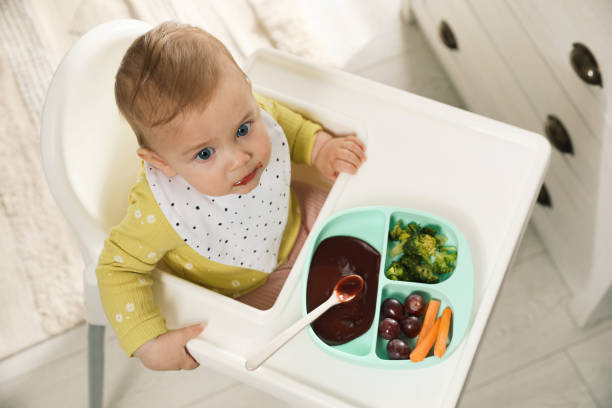Introduction:
Welcome to our blog dedicated to the caregivers of children. We understand that feeding a picky eater can be a challenging task, especially when it comes to packing their lunchbox for daycare or preschool. In this edition, we will delve into the world of picky eating, providing you with valuable insights and practical strategies to overcome lunchbox challenges while expanding your child's food choices.
Picky eating is a common phase that many children go through, characterized by their selective preferences and reluctance to try new foods. As a primary caregiver, you may find yourself frustrated and concerned about your child's limited food repertoire and nutritional intake. However, it's important to note that picky eating is a normal part of a child's development and is often temporary.
By addressing picky eating during the critical period of 2 to 3 years, you can positively influence your child's eating habits and set the foundation for a lifetime of healthy choices. This stage is particularly significant as children are starting to explore their independence and assert their preferences, making it an opportune time to introduce a wide variety of foods and flavors.
In addition to the usual challenges of dealing with picky eating, the transition to daycare or preschool can further complicate mealtimes. Your child may encounter unfamiliar foods, different mealtime routines, and social influences that can impact their eating habits. Therefore, we will also discuss strategies specifically tailored to navigate this new environment and ensure your child receives adequate nutrition during their time away from home.

Throughout this blog, we will provide you with practical tips, creative ideas, and evidence-based techniques to overcome lunchbox challenges and expand your child's food choices. Whether you're seeking advice on packing a balanced lunchbox, introducing new foods, or dealing with specific challenges such as allergies or sensory issues, we've got you covered.
Remember, each child is unique, and there is no one-size-fits-all approach. What works for one child may not work for another, and progress may take time. However, with patience, consistency, and a positive approach, you can help your child develop a healthier relationship with food, explore new flavors, and make mealtimes an enjoyable experience for the whole family.
So, join us on this journey as we explore the world of picky eaters and equip you with the knowledge and tools to conquer lunchbox challenges and expand your child's food choices. Together, we can create a nurturing environment that fosters healthy eating habits and sets the stage for lifelong well-being. Stay tuned for valuable insights and practical strategies tailored to your child's development!
Understanding Picky Eating
Understanding the underlying causes of picky eating and recognizing its potential impact on nutrition sets the stage for implementing effective strategies to expand your child's food choices. In the following sections, we will explore practical techniques to overcome lunchbox challenges, foster a positive mealtime environment, and gradually encourage your child to embrace a wider range of nutritious foods.
a. Definition and common causes:
Picky eating refers to a child's selective eating habits, where they show resistance or reluctance towards certain foods, textures, or flavors. It is essential to distinguish between normal picky eating, which is a typical part of a child's development, and a food aversion, which may require specialized attention.
Common causes of picky eating include a child's natural instinct for self-preservation, where they are cautious about unfamiliar foods to avoid potential harm. Additionally, children at this age are developing their autonomy and asserting their preferences, which can manifest in food choices. Sensory sensitivities, such as being sensitive to certain textures or smells, can also contribute to picky eating behaviors.
b. Differentiating normal picky eating from a food aversion:
Normal picky eating is a phase that many children go through. It involves selective preferences for specific foods or food groups, temporary aversions to previously enjoyed foods, and mild resistance to trying new foods. In most cases, children gradually outgrow this phase as they become more open to new tastes and textures.
On the other hand, a food aversion is a more severe and persistent form of selective eating. It often involves an intense dislike or fear of certain foods, leading to limited food choices and potentially compromising a child's nutrition. Food aversions can be associated with underlying sensory or developmental issues and may require professional intervention.
c. The impact of picky eating on overall nutrition:
Picky eating can have an impact on a child's overall nutrition and dietary diversity. When a child consistently refuses certain food groups or lacks variety in their meals, it may result in inadequate intake of essential nutrients, vitamins, and minerals necessary for their growth and development.
Common nutritional concerns associated with picky eating include a limited intake of fruits, vegetables, and whole grains, leading to a potential shortfall in fiber, vitamins, and minerals. Protein sources, such as lean meats, fish, and legumes, may also be restricted, affecting their muscle and tissue development. It is important to address picky eating to ensure your child receives a well-rounded and balanced diet.
Overcoming Lunchbox Challenges

By implementing these strategies, you can navigate lunchbox challenges effectively and ensure your child receives a nutritious meal that caters to their preferences and dietary needs. Remember, consistency and patience are key when introducing new foods and expanding their choices.
a. Importance of a balanced lunchbox:
A balanced lunchbox is crucial for providing your child with the necessary nutrients to support their growth and development. Aim to include a variety of food groups, such as carbohydrates, proteins, fruits, vegetables, and healthy fats, in each lunchbox. This ensures a well-rounded meal and increases the likelihood of your child receiving essential vitamins, minerals, and energy.
b. Strategies for packing nutritious meals that appeal to picky eaters:
i. Creative presentation and variety: Make the lunchbox visually appealing by incorporating a variety of colors, shapes, and textures. Use cookie cutters to create fun shapes from sandwiches or fruits. Including a mix of familiar favorites and new foods can also spark curiosity and encourage your child to try new things.
ii. Involving your child in meal planning and preparation: Allow your child to participate in meal planning and preparation. Take them grocery shopping and let them choose a new fruit or vegetable to try. Involve them in simple tasks like washing fruits or assembling a sandwich. This engagement can foster a sense of ownership and make them more receptive to trying new foods.
iii. Sneaking in nutrients through creative recipes: If your child is resistant to certain nutritious foods, get creative in incorporating them into other dishes. For example, blend vegetables into sauces or soups, or incorporate grated fruits or veggies into muffins or pancakes. This way, your child receives the nutritional benefits without being aware of the specific ingredients they may be avoiding.
c. Dealing with specific challenges:
i. Food allergies or intolerances: If your child has food allergies or intolerances, it's crucial to ensure their lunchbox is free from potential triggers. Familiarize yourself with alternative options and read food labels carefully. Communicate with the daycare or preschool staff about your child's dietary restrictions to ensure their safety and well-being.
ii. Texture or sensory issues: Some children may have sensitivities to certain textures or sensory experiences associated with food. Respect their preferences but gently encourage exposure to new textures gradually. For example, if your child dislikes crunchy vegetables, try lightly steaming or roasting them to soften the texture. Over time, they may become more receptive to different textures.
iii. Time constraints for preparation: Mornings can be hectic, leaving limited time for lunchbox preparation. Plan ahead by prepping ingredients or meals in advance. For instance, you can chop fruits and vegetables the night before or prepare extra servings of dinner for leftovers. Additionally, invest in practical lunchbox containers that make packing quick and easy.
Expanding Food Choices
By employing these strategies, you can gradually expand your child's food choices and help them develop a more adventurous palate. Celebrate small victories and acknowledge their efforts in trying new foods. Remember, every child is unique, and progress may vary. Focus on creating a positive mealtime environment and nurturing their curiosity and willingness to explore new flavors.
a. Creating a positive mealtime environment:
Establish a positive atmosphere during mealtimes by promoting a calm and relaxed setting. Minimize distractions such as electronic devices and encourage family meals whenever possible. Make mealtimes enjoyable by engaging in pleasant conversations and modeling healthy eating behaviors.
b. Introducing new foods gradually:
Introduce new foods one at a time and in small portions. Offer them alongside familiar foods to increase acceptance. Encourage your child to explore and interact with the new food, even if they initially show resistance. Remember, it may take multiple exposures before they develop a liking for unfamiliar flavors.
c. Encouraging sensory exploration and tasting experiments:
Create opportunities for your child to explore different textures, smells, and tastes. Incorporate sensory play into their mealtime experience by allowing them to touch, smell, and interact with various food items. Encourage tasting experiments by offering a small sample of a new food and discussing its taste and texture together.
d. Role modeling and family meals:
Children learn by observing their caregivers, so be a positive role model by showcasing your enjoyment of a wide range of foods. Eat meals together as a family as often as possible, and let your child see you trying new foods. When they witness others enjoying different foods, it can influence their own willingness to try them.
e. Dealing with food preferences and dislikes:
Respect your child's food preferences but gently encourage them to explore beyond their comfort zone. Offer alternatives within each food group to ensure a balanced diet. For example, if your child dislikes broccoli, offer them other green vegetables such as peas or green beans. Gradually reintroduce disliked foods in different preparations or combinations to expand their palate.
f. The importance of consistency and patience:
Be consistent in your approach to expand your child's food choices. Keep offering a variety of foods, even if they are initially rejected. It may take multiple attempts before your child accepts a new food. Stay patient and avoid pressuring or forcing them to eat. Remember, creating a positive association with food is essential for long-term healthy eating habits.
Transitioning to Daycare or Preschool

By actively communicating and collaborating with the daycare or preschool, you can ensure that your child's lunchtime experience is supportive, enjoyable, and conducive to expanding their food choices. Regularly check in with the childcare provider to understand your child's progress and address any concerns or challenges that may arise.
a. Communicating with the childcare provider:
Establish open and effective communication with the daycare or preschool staff regarding your child's dietary preferences, restrictions, and any allergies or intolerances they may have. Share information about your child's eating habits, including their favorite foods and specific challenges they face with certain foods. This collaboration ensures that the childcare provider understands your child's needs and can support them appropriately.
b. Discussing dietary preferences and restrictions:
Have a detailed discussion with the childcare provider about your child's dietary preferences and restrictions. Provide a list of preferred foods and any foods that your child should avoid due to allergies or intolerances. Offer suggestions for alternative options that can be included in their meals or snacks, ensuring that their nutritional needs are met.
c. Packing a familiar and appealing lunchbox:
When preparing your child's lunchbox for daycare or preschool, include familiar foods that they enjoy. This can provide them with a sense of comfort and security during mealtime away from home. Ensure that the lunchbox contains a variety of nutritious options from different food groups, including their preferred fruits, vegetables, proteins, and carbohydrates.
d. Encouraging peer interaction and food exploration:
Daycare or preschool provides an opportunity for your child to observe and interact with peers during mealtime. Encourage them to eat with others and engage in positive social interactions around food. Peer influence can have a significant impact on a child's willingness to try new foods. Encourage your child to share their lunchbox or try a small portion of a peer's food to explore new flavors.
e. Collaborating with the school to establish a supportive eating environment:
Work together with the daycare or preschool to create a supportive eating environment. Share your strategies for dealing with picky eating and expanding food choices, and inquire about the school's approach to mealtime. Discuss the importance of allowing ample time for eating, avoiding food-related pressure, and encouraging a positive and inclusive atmosphere.
Remember, transitioning to daycare or preschool may initially pose some difficulties, but with consistent support and a collaborative approach, you can help your child navigate this new environment and continue to foster healthy eating habits.
Conclusion:
In conclusion, dealing with picky eaters and expanding their food choices can be a challenging task for caregivers of children. However, with the right strategies and a positive approach, you can overcome lunchbox challenges and create an environment that encourages your child to embrace new foods. Understanding the underlying causes of picky eating, such as natural self-preservation instincts and sensory sensitivities, is the first step towards addressing the issue. Distinguishing between normal picky eating and food aversions helps determine the appropriate approach and potential need for professional intervention.
To overcome lunchbox challenges, it is important to pack a balanced meal that includes a variety of food groups. Employing strategies like creative presentation, involving your child in meal planning and preparation, and sneaking in nutrients through inventive recipes can make the lunchbox more appealing and nutritious. Expanding food choices requires creating a positive mealtime environment, introducing new foods gradually, and encouraging sensory exploration and tasting experiments. Role modeling healthy eating behaviors, incorporating family meals, and respecting food preferences while gently encouraging exploration are effective approaches.
Transitioning to daycare or preschool adds an extra layer of complexity, but effective communication with the childcare provider, discussing dietary preferences and restrictions, packing familiar and appealing lunchboxes, and encouraging peer interaction and food exploration can help create a supportive eating environment outside of home. Remember, each child is unique, and progress may vary. Patience, consistency, and a nurturing approach are key in expanding your child's food choices. Celebrate small victories and continue to provide a positive mealtime experience that fosters their curiosity and enjoyment of food.

With the knowledge and strategies provided in this blog, you are equipped to navigate the challenges of picky eating and help your child develop a healthier relationship with food. Stay dedicated, seek support when needed, and celebrate the progress your child makes on their journey towards a varied and nutritious diet.
Disclaimer: The information provided in this blog is for educational purposes only and should not replace professional medical advice. If you have concerns about your child's eating habits or health, please consult a qualified healthcare provider.

